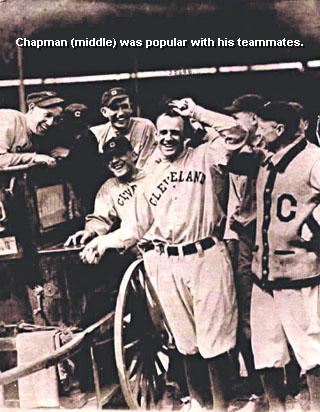|

Each year hundreds
of injuries take place on the baseball field. Players suffer injuries of varying degrees, everything from sprained ankles
and pulled hamstrings to broken bones and torn ligaments. These injuries can keep players out a few games, an entire season,
and in some extreme cases end careers. One player, however, paid the ultimate price while playing the game.
On August
16, 1920, life was good for 29 year old shortstop Ray Chapman. The speedy, slick fielding Chapman, anchor of the Cleveland
infield, was hitting .303 with 97 runs scored and his team was in the thick of the American League Pennant race. The Indians
were at the Polo Grounds in New York to take on the Yankees. Nasty submariner Carl Mays was on the hill for the Yanks. Chapman
was 0 for1 in the game when he led off the fifth against Mays. Chapman was known to crowd and sometimes lean over the plate.
Mays, known for his nasty disposition, had a reputation for throwing "high and tight."
Mays threw one of his patented
rising side armed pitches inside to the Indian's shortstop who was again crowding the plate. The pitch hit him in the temple
fracturing his skull. Chapman collapsed, blood ran out of his ears, nose, and mouth. His teammates rushed out and helped him
to his feet. According to some accounts Chapman regained consciousness, but quickly collapsed again before reaching the dugout.
Emergency surgery, which included the removal of a piece of his skull, was performed that night to no avail. Chapman died
at 4:30 the next morning, about twelve hours after being hit by Mays' pitch. It remains the only on field casualty in MLB
history.
Carl Mays voluntarily appeared in front of the homicide bureau of the district attorney's office that night
and was cleared of all wrong doing. Despite that fact the players of the Detroit Tigers and Boston Red Sox threatened to start
a petition to get Mays banned from baseball.
Back in Cleveland, H. O. Van Hart, the owner of First National Bank began
"A Flower from a Fan" campaign in which fans would contribute ten cents for a flower to be displayed at Chapman's funeral.
With rookie Joe Sewell in Chapman's place at shortstop, the Indians went onto win the franchises' first World Series
that year, wearing black arm bands as a tribute to their fallen teammate. Ray Chapman's wife, Kathleen, received his full
World Series share, just under $4,000.
For his career Chapman hit .278 with 233 stolen bases, 1053 hits, and 671 runs
in 1051 games over 9 big league seasons. He was known for his speed, he finished in the top ten in stolenbases three times
and in runs four times and his fielding - he was considered one of the finest glove men of the time. Chapman was selected
as one of the "100 Greatest Indians" when the team celebrated it's centennial in 2001. Noted baseball historian Bill James
said Chapman "was probably destined for the Hall of Fame had he lived."
Carl Mays went on to win 26 games for the
Yankees in 1920 and 27 more in 1921. He became the first man to win 20 games with three different teams in 1924 when he went
20-9 with Cincinnati (he also won 20 with Boston in 1917 & '18). Mays retired in 1929 with a 207-126 record and 2.92 ERA.
He felt the Chapman incident denied him admission into the Hall of Fame. Others believe that rumors that he threw at least
one game in the 1921 World Series, which his Yankees lost to the cross-town Giants, is to blame. A better explanation maybe
that he simply didn't have the numbers.
With the advent of batting helmets and significantly better medical technology
available, an incident like this would probably never happen in todays' game. It is important to remember, however, the legacy
of Ray Chapman, who was by all accounts an upstanding member of the community, a favorite of teammates and fans, as well as
a great ball player.
-David Zingler, February 2002
*FEEDBACK*
Chapman @ Baseball-Reference.com
Simply Baseball Notebook
DISCLAIMER: All pictures are assumed to be in the public domain. No violation
of copyright is intended here. If one of the photos above is not in the public domain, please notify us and it will be removed.
|

